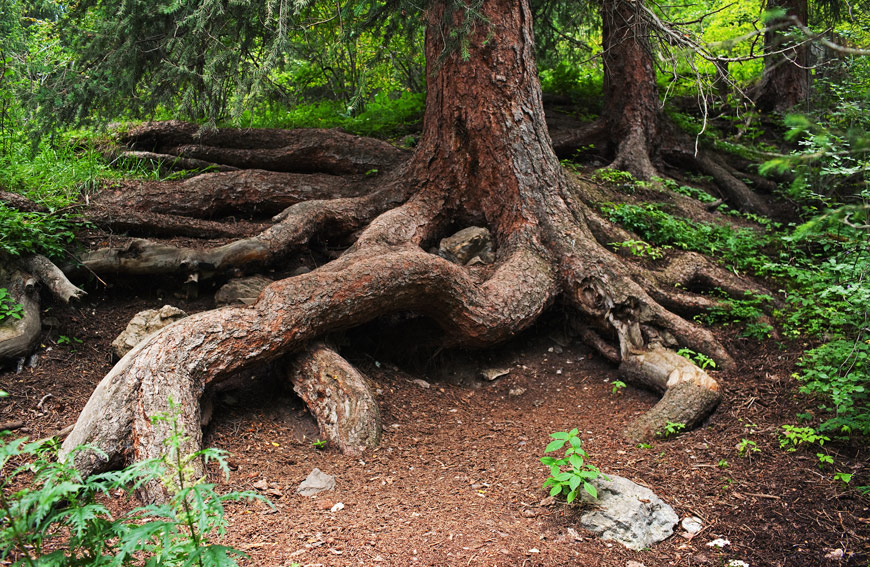Many home landscapes can be made better with evergreen pine trees. Since these are coniferous trees, they maintain their green appearance throughout the entire year, even in the winter. They also add wonderful texture, privacy, and smells to any yard. A lot of people tend to think about how tall and wide a tree will get, but they don’t stop to consider the depth a tree needs. This means considering how far and wide the root system is going to grow. Considering this is particularly important if you plan to plant a tree close to your house.
A standard safe distance to plant a tree by your house is 15 feet away. But this is not always possible, particularly if you bought a house with pre-existing trees. If the tree is still growing, you might need to consider how much more it’s going to grow and if it will impact your house or not, above and below ground. If you can see some roots that are growing close to your house, you might be wondering if you can cut them or not. Our team at Five Star Tree Services is going to go over the impact tree roots can have on the foundation of your home and if you should cut them.
Pine Root Spread
Have you ever stopped to wonder how far the roots of your tree are spread beneath the ground? Depending on the tree species, its roots are able to reach 2-3x the width of the drip line. The drip line is where the foliage ends and is the farthest distance from the tree.
Foundation Root Damage
For pine trees, they do not normally have invasive root systems. But under the right circumstances, for instance, if the earth is dry, any tree roots will go seeking a water source. Luckily, most roots can be found in the top foot of the surface of the soil. Different soil types can make roots grow differently in search for water, such as if the soil is sandy, compact, or clay. However, you can typically expect your tree roots to grow in an outward manner as opposed to downward. Things like downspouts, which are meant to carry water away from your house foundation, can aid in encouraging nearby tree roots to grow away from your house. To avoid downward growth of your tree roots, deep water watering can encourage this vs. shallow water watering.
Sidewalk Root Damage
Roots follow the water. If this means they need to go through or under a sidewalk, they will. They prefer favorable soil resources in order to maximize growth. In order to prevent problems, when planting trees, choose to plant them further away from sidewalks.
Cutting Above Ground Roots
There might be times when you can see the roots of a tree that’s close to your home. This might lead you to wonder if you can cut them or not. However, there are numerous factors that dictate the answer to this question. Some factors include the exact location of the tree roots and the size of them.
Unless you have tree roots that are infringing on a structure or causing damage to the structure, you should never remove them. As a general guideline, if you have tree roots coming close to your foundation, you should only cut them if they are less than 2 inches wide and are within a radius of 5x the stem diameter starting from the base of the tree. If you have larger roots outside of this radius, they can be cut but only on one side of the tree. The removal of large tree roots has the potential to make the tree unstable, unhealthy, or kill it. This is due to you removing a means of its water supply and nutrients. Always try to avoid cutting roots that are near the trunk of a tree, as these are very crucial to the structure of the tree. You should never remove more than 15% of a tree’s roots in one shot, even if they are above ground. When you cut its roots, your tree will take 2-3 years to recover. You will have to wait until after this to cut any more roots safely.
Preventing Root Damage
Luckily, you have a few different options for preventing root damage. For starters, when planting a pine tree, it’s important to pick the right one. There are a variety of root systems depending on what tree you get and the soil composition where you are planting it. Mugo pine trees and dwarf varieties, are one of the only pine’s that don’t have deep taproots. Larger species, like a white pine, that can grow 100-150 feet tall, are going to have a larger and more extensive root system. For different soil types, if you have sandy soil, this can make any pine tree develop multiple layers of roots.
The next thing you need to consider is the appropriate planting location. If your home foundation is solid and deep, it’s possible that the roots will find it but not cause any damage. However, if you have a weak foundation with cracks or a shallow depth, the roots will find their way in and follow the water and cause damage. The foundation of your house can even limit your tree’s growth. Because of these factors, it’s important to find the right location for your tree. Find a spot that’s not too close to your house, particularly when also considering the species you are planting and its future growth. Take some time to research how big a tree is going to get at maturity. This will help you avoid planting it too close to your house.
The last thing you can do is install root barriers by your foundation. These barriers are installed vertically in a trench located between your trees and your house foundation. They typically have chemical inhibitors in them, like copper, that trees don’t like to be around. You can also seal and treat your foundation during this time.
How Five Star Tree Services Can Help
If you have existing trees close to your house and you are worried that they are damaging your foundation, it might be a good idea to have them professionally removed. Our team at Five Star Tree Services can help with our Tree Removal Services in Toronto. Give us a call today at (416) 990-3355!


